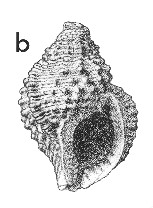
Revised descriptions of New Zealand Cenozoic Mollusca from Beu and Maxwell (1990)

 | Revised descriptions of New Zealand Cenozoic Mollusca from Beu and Maxwell (1990) | 
|
  (Pl. 30b): GS10343, D45/f8668, Nissen "no. 1" Shellbed, Park Bluff, Clifden, Southland, Waiauan (GNS) |
Beu & Maxwell (1990): Chapter 13; p. 263; pl. 30 b.
Synonymy: Argobuccinum (Haurokoa) woodi Fleming 1955a, p. 1056; Sassia (Haurokoa) woodi, Beu & Maxwell 1990, p. 263, pl. 30b.
Type species of Haurokoa Fleming, 1955
Classification: Ranellidae: Cymatiinae
Description: Moderately large for genus (40-65 mm high), wide and evenly inflated, with low, conic spire (0.5-0.7 height of aperture and canal) with only weakly convex whorls, large varices of thick, rounded cross-section every 0.67 whorl down whole teleoconch, and short, straight, moderately open anterior canal without fasciole. Protoconch large (4.0 mm wide, 3.7 mm high), turbiniform, of 3.7 superficially smooth, weakly convex whorls, with minute apex. Sculpture of low, wide, strap-like spiral cords with convex surfaces, with interspaces slightly narrower than to equal to width of 1 cord, and with 1 narrow, lower cord in each interspace in many specimens; primary cords raised at frequent (but irregular) intervals into low, narrow, laterally compressed nodules, weakly aligned into axial costae over some areas of some specimens, but merely forming an evenly, coarsely gemmate surface on most specimens. Aperture moderately large, oval; outer lip a thin flange reflected over inner third to half width of terminal varix, with prominent short ridges along its inner edge; inner lip wide, thick, forming a narrow, raised collar over neck and canal, bearing a single large parietal ridge, narrow, thin, basal columellar flange bearing numerous low ridges, and general surface sculpture of irregularly anastomosing ridges and wrinkles.
Comparison: Fleming (1955a) noted the resemblance of Haurokoa woodi to Argobuccinum Hermannsen, 1846 (Ranellidae: Ranellinae) in general shape and the shape of the varices. However, H. woodi has varices at each two-thirds of a whorl, rather than every half-whorl as in Ranellinae. It appears to have descended (through an intermediate, unnamed form) from Haurokoa marwicki (Kaiatan-Runangan; Pl. 7u), a small, narrow, but similarly gemmate species. Specimens from near Te Araraoa, East Cape (Kapitean) are larger and more complete than the illustrated shell or the type material of H. woodi. The genus appears to have descended from Sassia rather than Argobuccinum.
It is now clear that Haurokoa is recognisable as a genus differing from Sassia in its larger protoconch, its sculpture of many rows of similar, even, rounded nodules on all species, and its distinctive rounded aperture with a deeply excavated columella and the outer lip reflected widely over the terminal varix. The lineage of S. marwicki and S. woodi is well represented in New Zealand Eocene to earliest Pliocene rocks, but then became extinct. A distinctive, large, unnamed, coarsely sculptured species is present in a few collections from the Nissen Shellbeds (Waiauan) at Clifden, Southland. The other species group that belongs here, but is more finely sculptured, is those related to "Mayena" bartrumi Powell (1938a, p. 372, pl. 39, fig. 12), from Waiheke Island, Auckland (type; Otaian) and Paratoetoe, Parengarenga Harbour, Northland (Altonian). Similar but unnamed species are widespread but rare in Duntroonian greensand in Southland and Otago. Haurokoa is known also from Eocene to Middle Miocene rocks in southern Australia, and a single species appears to be represented by incomplete specimens from a Miocene locality in southern Chile.
Distribution: Waiauan-early Opoitian; Port Craig, Te Waewae Bay, Southland, Kapitean (type); Nissen Shellbeds at Clifden, Southland (Waiauan), scattered localities in Gisborne district (Tongaporutuan), Maruhou Point, between Te Araroa and East Cape (Kapitean), and Birch's Mill shell lens, Te Waewae Bay (early Opoitian). Widespread but uncommon in shallow-water, soft bottom assemblages. An early, slightly narrower form occurs at several Otaian-Atonian localitites; seen mainly from Pakaurangi Point, Kaipara Harbour (Otaian).
Cite this publication as: "A.G. Beu and J.I. Raine (2009). Revised
descriptions of New Zealand Cenozoic Mollusca from Beu and Maxwell (1990). GNS
Science miscellaneous series no. 27."
© GNS Science, 2009
ISBN
978-0-478-19705-1
ISSN 1177-2441
(Included with a PDF facsimile file
copy of New Zealand Geological Survey Paleontological Bulletin 58 in CD version
from: Publications Officer, GNS Science, P.O. Box 30368 Lower Hutt, New
Zealand)